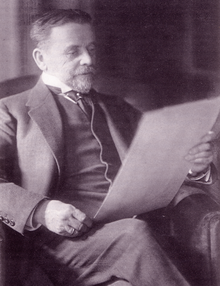Ludwig Hoffmann (architect)
| Ludwig Hoffmann | |
|---|---|

Ludwig Hoffmann
|
|
| Born |
30 July 1852 Darmstadt, Hesse |
| Died | 11 November 1932 (aged 80) Berlin |
| Nationality | German |
| Occupation | Architect |
| Awards | Honorary citizen of Berlin |
Ludwig Ernst Emil Hoffmann (30 July 1852 – 11 November 1932) was a German architect and was one of the most famous architects of Berlin.
Ludwig Hoffmann was born in Darmstadt and educated at the Kunstakademie Kassel (Kassel Academy of Art) and the Bauakademie (Academy of Architecture) in Berlin. In 1879, after passing the first state examination, Hoffmann began working for the government of Berlin as a construction foreman under Franz Heinrich Schwechten. His architectural career began in 1880 when he and Peter Dybwad, both unknowns, won the competition to design the Supreme Court building in Leipzig against 118 other entries. In 1895, the year it was completed, he returned to Berlin and that June married Marie Weisbach, a banker's daughter.
In 1896, Hoffmann became Stadtbaurat—director of urban planning and construction—for Berlin. He served for 28 years until 1924 (mandatory retirement age being 72) and is now regarded as the most important holder of the position.
Under his leadership 111 facilities were built, including over 300 buildings. He designed the new administration building for the city of Berlin, now known as the Altes Stadthaus (1902—1911). He designed the Märkisches Museum (1899—1904), the museum of Berlin and the Mark Brandenburg. With Alfred Messel, he designed the built version of the Pergamon Museum on Museum Island (1910—1930). In addition he designed bridges, fountains, public baths, schools of every kind, orphanages, hospital complexes, cemeteries, private villas, and apartment buildings. In his memoirs, he describes the long history of work on the Märchenbrunnen (fountain of fairy tales) for the Volkspark Friedrichshain, the first public park in Berlin. Hoffmann had a significant impact on the urban development of Berlin both through his own designs and as a judge for many architectural competitions, although some of his projects were not constructed due to the outbreak of World War I, many were destroyed in World War II, and others were later demolished. An archive of many of his designs is kept at the Architecture Museum of the Berlin Institute of Technology.
...
Wikipedia
